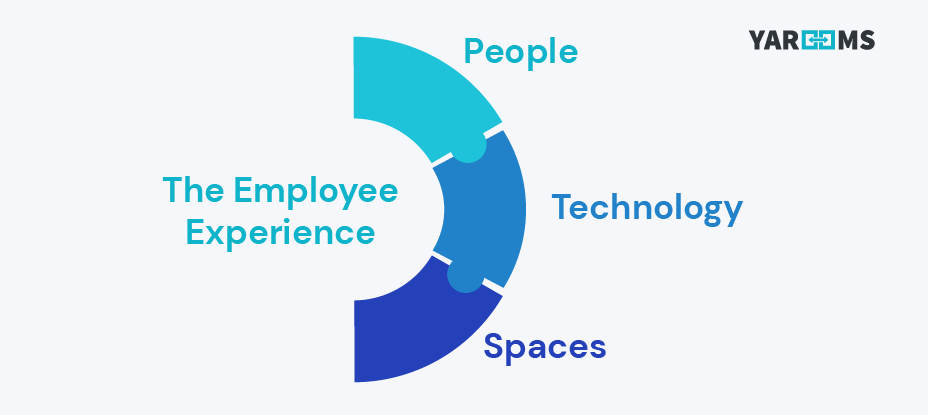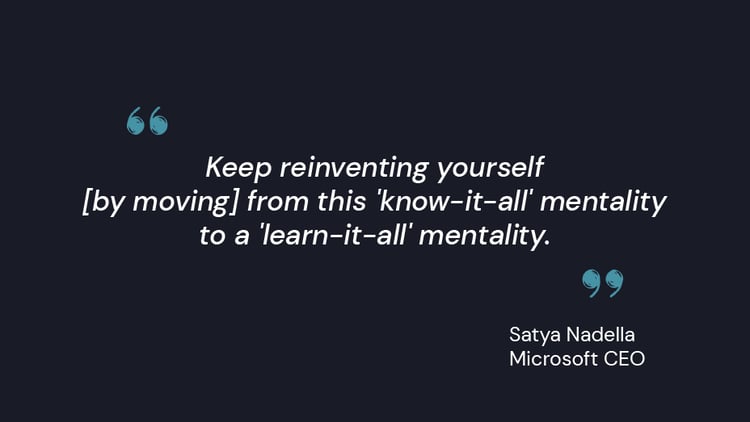Are you struggling to engage and retain top talent in your organization? Is productivity dipping and employee engagement sinking lower than the sea level?
If you nodded yes, perhaps it's time to reflect upon what's missing in your company culture. More often than not, an underestimated factor causing these challenges is a lack of efficient employee experience strategy.
Therefore, this article unravels the secrets of developing a successful employee experience strategy that guarantees results, offers innovation, and improves productivity, all while sharpening your competitive edge. Ready to dive in?
TL;DR:
- Employee experience strategy is a holistic approach that optimizes interactions and the overall employee lifecycle within the workplace.
- It includes the physical environment, company culture, HR leadership practices, and technological tools.
- Companies investing in employee experience are four times more profitable.
- Key elements of employee experience strategy: actively listen through feedback (consider employee engagement surveys, exit interviews, etc), map employee lifecycle journeys, foster cross-functional collaboration, focus on high-impact touchpoints, and embrace agile design principles.
- Lack of clear vision, resistance to change, resource constraints, and difficulty measuring results are the main challenges companies face when building their employee experience strategies.
What is an Employee Experience Strategy?
Employee experience strategy refers to a holistic approach adopted by organizations to enhance and optimize the overall journey and interactions that employees have within the workplace. It encompasses various facets, including the physical work environment, organizational culture, leadership practices, and the technological tools provided to employees.
An effective employee experience strategy aims to create a positive and engaging work environment that fosters employee satisfaction, productivity, and retention throughout the entire employee lifecycle. This strategy recognizes the importance of employee well-being, professional development, and work-life balance, acknowledging that a positive experience for employees directly correlates with improved organizational performance.
By aligning the company's values with the needs and expectations of its workforce, a well-crafted employee experience strategy can contribute to a motivated and committed workforce, ultimately leading to tremendous success for the organization.
Defining Employee Lifecycle
In this article, we have mentioned the term "employee lifecycle" a few times, so it's probably worth defining it. The employee lifecycle refers to the stages an employee goes through during their time with a company, from onboarding to eventual exit. HR teams focus on optimizing each stage—recruitment, onboarding, development, retention, and offboarding—to ensure engaged employees who align with company culture. Employers can gather insights to nurture talent, reduce turnover, and strengthen the overall employee experience using employee surveys.
Benefits of Employee Experience Strategy for Businesses
We spend a significant proportion of our lives at work, making the experiences we have in workplaces crucial. If you're wondering why businesses should focus on building an employee experience strategy, the answer is straightforward: it brings multiple benefits that can transform a business's overall outlook and trajectory.
Amplified Company Performance
Stronger financial performance is often linked with positive employee experiences. A study by Jacob Morgan found companies that invest in employee experience are four times more profitable than those that don't.
Better experiences might not immediately translate to higher revenues, but the effect compounds over time and positively reflects on the bottom line. Therefore, improving your employees' workplace experiences isn't just good ethics; it's an exceptional business strategy, too.
Enhanced Talent Attraction and Retention
In today’s competitive marketplace, having a premier product or service doesn’t guarantee success. It’s also about attracting and retaining top talent. Hence, one cannot ignore why focusing on employee experience is integral to this process.
When organizations prioritize their employees’ experiences, they build an employer brand coveted by prospective job seekers. Strong employer branding leads to 50% more qualified applicants. High levels of engagement from satisfying workplace experiences also result in higher retention rates - reducing turnovers and associated recruitment costs.
Higher Employee Engagement
Higher employee engagement is a significant benefit of an effective employee experience strategy. By focusing on comprehensive onboarding processes and continuous career development opportunities, HR teams can foster a work environment where employees feel valued and motivated. This engagement is further strengthened through regular recognition and feedback, making employees feel appreciated for their contributions. Employees who are highly engaged are more likely to stay with the company, reducing turnover rates and enhancing overall productivity. Thus, prioritizing employee engagement within the employee experience strategy directly contributes to a more committed and high-performing workforce.
Employee Experience vs. Employee Engagement
Employee experience and employee engagement are closely related but distinct concepts that HR professionals must understand to optimize the employee lifecycle. Employee experience encompasses the entire journey an employee takes with a company, from onboarding to exit, including every interaction and touchpoint. In contrast, employee engagement refers to the emotional commitment and enthusiasm employees feel toward their work. While a positive employee experience lays the foundation for engaged employees, engagement surveys, recognition programs, and targeted initiatives to increase employee engagement are necessary to sustain and enhance that commitment throughout the employee lifecycle. HR can create a more motivated and productive workforce by focusing on both.
Culture of Innovation
Creativity thrives when people feel comfortable and valued—a key highlight of excellent employee experiences. For example, Google often garners accolades for its innovative practices predominantly because they've fostered an environment where ideas are heard regardless of one's position within the company structure.
Structuring your business to prioritize enjoyable employee experiences can result in a culture of innovation that continuously drives growth and makes change nimble.
Higher Customer Satisfaction
There's an undeniable chain reaction from employees to customers: happier employees lead to more pleased customers. There's a strong correlation between positive employee experiences and customer satisfaction. This gains significance considering satisfied customers are repeat customers; those who advocate for the brand attract more new businesses, essential for survival in the cutthroat corporate world.

Factors Influencing Employee Experience
A crucial part of implementing an effective workplace employee experience strategy involves understanding the key elements that influence it. Three primary factors to consider are the physical workspace, people and culture, and workplace technology.
Physical Workspace
Believe it or not, the physical environment remarkably affects how we perceive our tasks and, subsequently, our overall performance. An inspiring office design can foster creativity, while a comfortable workspace encourages concentration and productivity.
The design aspects shouldn't only be limited to aesthetics; they should also foster collaboration, cater to employees' comfort needs, and promote healthy lifestyle habits. For example, embodying natural light in the workspace enhances mood and energy levels among employees, leading to higher job satisfaction. Each detail shapes the workplace employee experience in subtle but powerful ways.
People and Culture
The second factor is all about how things are done. This often-quoted definition of organizational culture accurately summarizes its importance when considering employee experience. Employees thrive in environments where personal development is encouraged, individual contributions are recognized, diversity & inclusion are valued, grievance redressal mechanisms are solid, open communication becomes second nature, and work-life balance isn't longer an HR buzzword.
However, achieving this warming sense of belonging requires active involvement from every individual within an organization - from top-level management to entry-level employees. When everyone shares common values and goals bounded by mutual respect for one another's individuality, trust, motivation, and engagement, among other positive traits, naturally emerge, enhancing the overall workplace employee experience.
Workplace Technology
Having touched upon the "what" (physical workspace) and "how" (organizational culture), let's turn our focus on tools. Adopting advanced technologies that simplify tasks and enhance productivity makes work less tedious and almost becomes necessary in our fast-evolving digital world.
Effective use of technology can streamline work processes, promote efficient collaboration, and automate routine tasks—such as using an email API to send personalized onboarding or performance-review reminders—freeing up valuable time for employees to focus on meaningful work.”Organizations must remain updated about the latest technology disruptions relevant to their industry and implement them systematically to improve the workplace employee experience.
However, as beneficial as these advancements may be, ensure there isn't an over-emphasis on virtual engagement at the cost of genuine human interaction.

Key Components of an Effective Employee Experience Strategy
Creating a compelling employee experience strategy requires a systematic, holistic approach. As such, it involves tuning into the voice of your employees and investing in critical touchpoints between your workforce and management, amongst other strategies. Let’s elaborate on some fundamental elements that can revolutionize employee experience design.
Feedback: Tuning into the Voice of the Employee
A key element of effective employee experience strategies involves actively listening to your employees' thoughts and feelings about their jobs and work environment. HR teams can take a proactive approach by seeking their opinions through surveys or feedback channels. These tools show that you value their input and provide valuable insights into potential areas that may need attention.
Creating a culture that genuinely values feedback will encourage more genuine and open responses from your employees. Their insights can be pivotal in shaping a workplace culture that fosters positivity. So, by actively listening and acting on feedback, you demonstrate your commitment to their well-being and contribute to a more positive and engaging work environment.
Employee Journey Maps to Identify Pain Points and Improvement Areas
In crafting a dynamic employee experience strategy, it's crucial to thoughtfully plot out each employee's course within your organization, often referred to as their employee journey. This strategic approach entails identifying key stages throughout an individual's employment lifecycle (employee lifecycle), from recruitment to departure.
By meticulously mapping out this journey, you gain insights into potential obstacles that may impede employee satisfaction, well-being, or employee engagement. Simultaneously, you'll pinpoint opportunities for improvement. A stellar employee experience model leverages this mapped-out journey as a compass, positively directing initiatives to address identified pain points or gaps. This way, you navigate challenges and proactively enhance the overall employee experience.
A Cross-functional Employee Experience Coalition for Collaboration and Alignment
To methodically elevate the overall employee experience, it's essential to assemble a collaborative, cross-functional team that brings together individuals from diverse departments and levels within the company. This collective group should work cohesively to align distinct objectives with the aim of improving the current employee experience.
Engage everyone in this effort, from HR professionals and Facility managers to IT personnel, as each brings unique perspectives that are valuable to consider. By involving various voices, you create a comprehensive coalition that ensures any developed employee experience design is holistic, well-rounded, and beneficial to all stakeholders. This inclusive approach captures a broader range of insights and fosters a sense of unity in pursuing a common goal.
High Impact Touchpoints, such as Onboarding and Performance Reviews
Some junctures in the employee journey have a more significant influence on the overall work experiences of your staff. Consequently, directing strategic investments toward optimizing these high-impact touchpoints can significantly elevate employee satisfaction levels.
Noteworthy moments to focus on include the onboarding process, where getting it right establishes a foundation for ongoing success for new hires within your company. Likewise, performance reviews offer valuable opportunities for personal growth when approached with constructive and compassionate methods.
By pinpointing and enhancing these critical touchpoints, you actively demonstrate a commitment to creating an environment where employees thrive and feel genuinely appreciated.
Agile Design Principles for Continuous Improvement
Lastly, don’t expect immediate perfection when implementing employee experience strategies! Instead, adopt an agile mentality centered on continuous improvement:
- Test out different initiatives.
- Review their effectiveness using suitable metrics.
- Refine these procedures based on gathered feedback and repeat this cycle until you realize an optimal employee experience model.
Incorporate innovation whenever possible because effective employee experience strategies benefit from dynamic progression rather than stagnant repetition. Embrace changes within the workspace positively, so you cultivate a vibrant community that encourages progress over time rather than instant excellence.
Examples of Successful Employee Experience Strategies
If you want to improve your employee experience strategy, looking at successful frameworks implemented by other companies can be beneficial. Let's explore some organizations that have effectively harnessed their employee experience strategies for maximum impact.
Salesforce: Prioritizing Employee Wellness
Salesforce has continuously topped "The Best Places to Work" lists. One reason is its commitment to fostering a healthy and inclusive work environment. Notably, Salesforce introduced the 'Ohana' culture, which underscores the importance of health and wellness as one of the pillars of exceptional employee experience.
Microsoft: Promoting Growth Mindset
Microsoft is another excellent example when it comes down to uplifting the employee experience. Under Satya Nadella's leadership, there has been a concerted move from a know-it-all culture to a learn-it-all culture, instilling a growth mindset across all organization sectors. In this systemic change, employees' feedback is essential in helping address pain points not just reactively but proactively.
Implementing an Employee Experience Strategy: 5 Essential Steps
Now, let's dive into the central part of our conversation—how to implement a successful employee experience strategy. Here, you'll find a straightforward guide consisting of five essential steps.
Step #1: Defining Overall Goals and Objectives for the Strategy
Step number one involves clarifying your objectives. Without clear goals, any strategy is akin to sailing without a compass—you must know which direction you're heading in before you set sail. Shaping this vision requires understanding what work experience suits your employees best. Ask yourself critical questions such as what defined outlook you aim for regarding job satisfaction, engagement levels, productivity, employer branding, and retention rates.
Step #2: Gathering Feedback from Employees across the Organization
The input from employees is crucial—it provides invaluable insights into their needs, concerns, and expectations. To gather feedback effectively:
- Distribute regular employee engagement surveys with pinpointed questions about workplace culture, physical environment, or technology use.
- Encourage informal feedback aside employee surveys, sharing using internal platforms or meetings.
- Conduct exit interviews – they offer unique perspectives on why some employees leave and highlight areas that need improvement.
Remember, honest shared experiences are powerful tools for enhancing employee experience.
Step #3: Mapping out Employee Journeys to Identify Areas for Improvement
Once you've collected feedback, it's time for analysis. By mapping out employee journeys—one of the core elements of a successful strategy—you'll get a clear picture of how employees interact with various aspects of their work life at different stages.
Look for trends amongst differing roles within the company; identify their defining moments—positive or negative—and, based on those findings, extract specific areas requiring enhancement.
Step #4: Creating a Detailed Action Plan
Armed with defined goals and rich data derived from feedback and journey maps, begin developing your unique action plan, breaking it down into tangible tasks. Outline precisely how you will improve identified weak areas and enhance the strengths. Keep it collaborative—involve key stakeholders to consider all relevant perspectives while devising your plan.
Step #5: Utilizing Technology to Support the Strategy Implementation
Lastly, employ technology as your ally in this crusade for an optimized employee experience. Use advanced survey creation or feedback collection solutions, virtual workspace enhancement tools, or all-around workplace experience platforms like Yarooms. Technological solutions serve as support systems to implement your strategy more efficiently and harness a data-driven approach in the constant refinement process of your strategic blueprint.
Follow these five steps, and you'll have a roadmap ready towards achieving an authentic, evolving, and result-oriented employee experience strategy—one that doesn't just exist on paper but actually works!
Challenges in Creating a Solid Employee Experience Strategy
While creating a solid employee experience strategy is an important endeavor, it’s not without its hurdles. Implementing the proper procedures requires careful thought and planning, as well as patience to overcome certain obstacles that may come your way.
Lack of Clear Vision
An initial challenge can be sketching out a defined vision for what you want your employee experience to look like. This step demands time and involvement from key decision-makers in the organization. You must set clear goals before crafting strategies or actions so everyone understands the end game.
Resistance to Change
Even with a clear vision, employee resistance to workplace change often poses a significant obstacle. Changes to the routine can elicit fear or pushback among staff members who are already comfortable with existing workflows. Overcoming this barrier involves firm communication and support during transitional periods, assuring employees at every turn.
Resources Constraints
Another hurdle could be limited resources - both financial and non-financial. Developing a comprehensive employee experience strategy will require investment in tools, technologies, training programs, human resources, and sometimes even changes in physical workspace arrangements. Balancing budget constraints while driving toward improvement often proves to be quite tricky.
Difficulty Measuring Results
Complications don't end post-implementation; assessing progress is another challenging task due to inherently qualitative elements of employee satisfaction, which are hard to quantify. Relying solely on tangible metrics might lead us astray from capturing genuine sentiment.
Keeping these challenges in mind equips you better for dealing with problems as they arise. Remember: all exceptional things face opposition initially. So embrace these challenges head-on because overcoming them will mold your institution into one where workers feel valued - paving the way for long-term success.
Measuring Success and Continuous Improvement in Employee Experience Strategy
This being said, let’s explore the critical metrics and ongoing refinement processes that ensure your employee experience improvement efforts consistently exceed the evolving needs of your workforce.
Establishing Metrics for Evaluating the Effectiveness of the Strategy
Determining the success of an employee experience strategy hinges on establishing clear, measurable, and relevant key performance indicators (KPIs). These KPIs should be aligned with your organizational goals and values. Examples worth considering include employee engagement, job satisfaction, turnover, absenteeism, productivity metrics, internal mobility trends, workforce diversity, and inclusivity statistics. Remember that these measures paint a holistic picture of the state of your employee experience management.
Collecting Ongoing Employee Feedback
To ensure your efforts are bearing fruit, you must consistently listen to what your employees say about their experiences in your organization. This can be done through various methods, such as continuous pulse surveys, suggestion boxes, or regular touchpoints during team meetings. Digital platforms that collect such feedback can offer real-time data and insights that truly make a difference. It's essential to gather this information and demonstrate that you're using it constructively - this fortifies trust amongst your workforce.
Analyzing Data to Identify Areas for Improvement
Critical analysis of qualitative and quantitative workplace data paves the way for identifying improvement opportunities within your employee experience strategy. To do so effectively, you must consider all facets of data from compiled metrics and anecdotal evidence gathered via employee feedback tools because sometimes numbers cannot capture everything. Analyze patterns over time rather than isolated instances for more insightful outcomes – this allows you to zero into hotspots needing priority attention when refining the strategy.
Continuously Refining and Enhancing the Employee Experience Strategy
Remember that cultivating exceptional workplaces is not a one-off event but a sustainable cycle geared towards constant betterment. Thus, leverage insights derived from established metrics, ongoing feedback, and diligent data analysis, then use these findings to recalibrate interventions iteratively. Regular updates regarding what changes have been made and why go a long way in illustrating your commitment to improving employee experience. In the long run, this will foster an environment of transparency where employees feel valued and heard – significantly enhancing your ongoing employee experience management endeavors.

The Future of Employee Experience
As we look ahead, it's clear that the employee experience will continue to evolve, driven by emerging trends and innovations. These changes promise exciting new opportunities for improving workplace engagement and productivity. However, they also present significant challenges that companies must overcome to keep pace with the modern working environment.
Evolving Trends and Technologies Shaping The Employee Experience Landscape
One of the notable influences driving change in the employee experience is technology advancement. Its impact on work cannot be understated – from how tasks are executed to where job roles can be fulfilled.
For instance, artificial intelligence (AI) and machine learning developments offer great potential for automating repetitive tasks. This diversion allows employees more time to focus on fulfilling high-value job functions, enhancing their workplace experience.
Another influential trend shaping workplace dynamics is hybrid work. Influenced considerably by recent circumstances such as worldwide health crises, businesses have had to rethink methods for maintaining a positive employee experience outside traditional office environments.
Finally, data analytics is emerging as a powerful tool for understanding workforce patterns and making informed decisions regarding employee engagement strategies. With increasingly sophisticated software applications available today, organizations can monitor real-time metrics, thus providing vital insights into what drives satisfaction among team members.
Tom Winter talks about AI in the workplace. WorkplaceWhiz podcast, ep. 3”.
Predicted Future Challenges and Opportunities
While these trends offer an optimistic vision for future workplaces, they face challenges. Most notably, it’s about integrating these technologies into current operations without causing disruption or anxiety amongst staff members - balancing human input with automated processes will require keen navigation.
Similarly, fostering genuine connection and cultivating culture in an increasingly digital workspace pose additional hurdles. With more teams functioning remotely or across varied locations, preserving a unified company spirit requires deliberate effort.
Despite these considerable efforts necessary to adapt successfully as workplace norms evolve, significant opportunities lie in store, too—for example, harnessing data analytics to identify problem areas in your employees' journey can transform their experiences positively.
By deliberately using emerging technologies and methodologies, companies can create a dynamic employee experience framework that caters to worker needs better than traditional models.
The future of work is undoubtedly an exciting landscape filled with promise and potential. Armed with commitment, innovation, and strategic foresight, businesses can successfully stride into this new era—and, more importantly—pave the way for their employees to do the same.
Final Thoughts
As we conclude our exploration of employee experience strategy, it's crucial to emphasize its dynamic nature, requiring continuous adaptation to evolving emotions and expectations in our information-driven age. Adopting an active approach, leveraging collaborative technologies, and fostering inclusivity are key. Happy employees lead to satisfied customers and robust bottom lines, emphasizing the importance of proactive responsiveness to change. Success lies in framing an efficient strategy and establishing a collective, celebratory atmosphere that values every contribution and creates a thriving work environment. Building a successful employee experience strategy may seem daunting, but, like conquering Everest, determination and well-strategized plans can lead to triumph.









